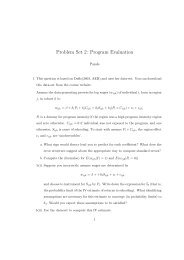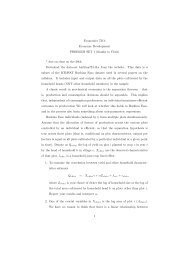The Expected Utility Model: Its Variants, Purposes, Evidence and ...
The Expected Utility Model: Its Variants, Purposes, Evidence and ...
The Expected Utility Model: Its Variants, Purposes, Evidence and ...
Create successful ePaper yourself
Turn your PDF publications into a flip-book with our unique Google optimized e-Paper software.
Schoemaker: <strong>The</strong> <strong>Expected</strong> <strong>Utility</strong> <strong>Model</strong><br />
535<br />
for separating v(x) <strong>and</strong> u(x): namely,<br />
group decision making. In an organizational<br />
context it may be desirable only to<br />
have members' inputs regarding their<br />
v(x) functions, but not their risk attitudes<br />
(which might be centrally determined).<br />
Finally, cardinal utility under certainty<br />
may be useful for welfare theory (Dyer<br />
<strong>and</strong> Sarin, 1979b), although it seems to<br />
suffer as well from impossibility theorems<br />
(T. Schwartz, 1970).<br />
<strong>The</strong> distinction between v(x) <strong>and</strong> u(x),<br />
denoting cardinal preference scalings under<br />
certainty <strong>and</strong> risk, respectively, is often<br />
overlooked or has been a source of<br />
considerable confusion, even among experts.<br />
During the beginning of the 1950s,<br />
<strong>The</strong> Economic Journal <strong>and</strong> Econornetrica<br />
published a variety of articles debating the<br />
cardinality of NM utility (e.g., Herman<br />
Wold, 1952 <strong>and</strong> Armen Alchian, 1953).<br />
Amid considerable confusion, lucid analyses<br />
were offered by Robert Strotz (1953),<br />
Daniel Ellsberg (1954) <strong>and</strong> John S. Chipman<br />
(1960). Ellsberg compared how such<br />
classical utilitarians as William Stanley Jevons,<br />
Carl Menger, Leon Walras or Alfred<br />
Marshall might have predicted choice under<br />
risk with the approach taken by NM.<br />
<strong>The</strong> difference lies in the way the utility<br />
function is constructed: namely, under<br />
certainty or risk. Which expectation<br />
model will predict better is an empirical<br />
question. An important difference, however,<br />
is that the E[v(Z)] model has no normative<br />
justification other than its face validity,<br />
whereas the E[u(Z)] model derives<br />
from a set of appealing decision axioms.<br />
It is my interpretation that Bernoulli proposed<br />
the v(x) type expectation model,<br />
although he never explicitly addressed the<br />
measurement question.<br />
<strong>The</strong> above discussion on cardinal utility<br />
was provided because, even today, the distinction<br />
between v(x) <strong>and</strong> u(x) is often<br />
unrecognized. Textbooks in economics<br />
<strong>and</strong> management science occasionally discuss<br />
the NM function as if it only measured<br />
intrinsic pleasure under conditions of certainty.<br />
For example, a concave u(x) might<br />
erroneously be interpreted as implying<br />
that equal increments in money (under<br />
certainty) contribute to utility at a decreasing<br />
rate. Of course, v(x) is confused<br />
here with ~(x). Apart from textbook confusions,<br />
the above distinction is occasionally<br />
not recognized in research designs.<br />
For example, in a study of simulated reallife<br />
decisions, such as whether or not<br />
to enroll in a Ph.D. program, Thomas<br />
Bonoma <strong>and</strong> Barry R. Schlenker (1978)<br />
considered subjects suboptimal if they did<br />
not maximize Z piv(~i); what these authors<br />
should have tested, in making such<br />
normative evaluations of risky choices, is<br />
whether Z piu(xi) was maximized.<br />
To summarize, v(@ was defined as<br />
an interval-scaled utility measure constructed<br />
under conditions of certainty,<br />
similar to neoclassical utility except that<br />
no ratio properties are presumed. In contrast,<br />
u (@ is a cardinal NM utility measure<br />
derived from preferences among lotteries.<br />
<strong>The</strong>se two utility functions only need to<br />
be monotone transforms of each other.<br />
Thus when presented with different commodity<br />
bundles g under certainty, v(F)<br />
<strong>and</strong> u(@ should yield the same ordering<br />
for a person satisfying the axioms underlying<br />
either construct. However, when presented<br />
with risky prospects Zi the formally<br />
correct ordering is determined from<br />
E[u(Zi)], which will generally differ with<br />
that obtained from E[v(4)] unless v(x) is<br />
a linear transform of u(x). Finally to obtain<br />
an interval ranking of the risky prospects<br />
Zi, the E[u(i)] could be inverted into<br />
their certainty equivalents C4 which<br />
might then be interval ranked by computing<br />
v(C4).<br />
c. <strong>The</strong> Concept of Probability<br />
Other potentially confusing aspects of<br />
the expected utility model concern the<br />
treatment of probabilities. In the NM axiom<br />
system probability is considered a




